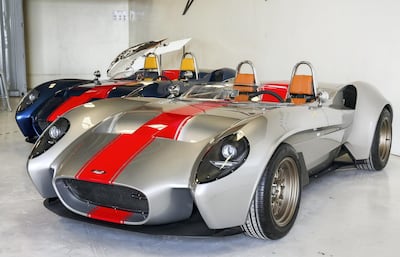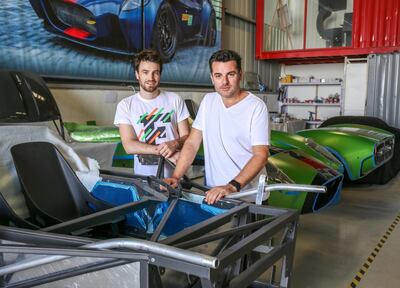Anthony Jannarelly, the co-founder of the Dubai-based custom-built sportscar maker Jannarelly Automotive, is a dyed in the wool petrol head for whom driving is all about how a car makes you feel. Yet even he accepts that battery-powered cars nowadays are a force to be reckoned with.
“I do believe in the electric car, it’s the future for sure,” says the man behind the firm’s petrol-powered retro-styled Design-1 two-seater. So much so, in fact, that his company is jumping on the bandwagon.
“We are working on an electric drivetrain,” he exclusively told The National last month at the company’s modest manufacturing facility in Dubai’s Al Jaddaf industrial complex, spurred on by consumer demand in the US.
“To diversify the range we will go electric because, for instance in California, we have so many people asking for the car in electric. Every time we show the car, people are asking, “Is there an electric version?’”
The move to make an electric version of its sportscar comes as the rise in demand for electric vehicles is accelerating worldwide.
Sales of battery electric vehicles and plug-in hybrids exceeded 287,000 units in the three months ended in September, 63 per cent higher than the same quarter a year earlier, and up 23 per cent from the second quarter, according to a report by Bloomberg New Energy Finance.

Such demand comes as governments around the world set ambitious targets for cleaner transport. France and the UK said they will ban sales of new petrol and diesel-burning cars by 2040, while the Netherlands is targeting that all new cars sold by 2030 will be emissions-free. China is considering similar targets, with even the car-saturated US state of California considering following suit.
Embracing such a policy would send shockwaves through the global car industry due to the heft of California’s car market. More than 2 million new passenger vehicles were registered in the state in 2017, more than France, Italy or Spain.
“There are people who believe, including who work for me, that you could stop all sales of new internal-combustion cars by 2030. Some people say 2035, some people say 2040,” Mary Nichols, chairman of the Californian Air Resources Board, told Bloomberg in September.
“It’s awfully hard to predict any of that with precision, but it doesn’t appear to be out of the question.”
Jannarelly Automotive is seeing a shift in customer preferences, albeit it on a small scale.
“We already have one client [in California] who has ordered an electric version, with very specific requirements, so we have a special project for this,” Mr Jannarelly says.
The two-year-old company has, however, been shrewd in its approach to electrifying the Design-1.
“We said we can do that, but let’s do just 10 cars in a special edition,” Mr Jannarelly says.
By doing so the company can get to grips with the process of making an electric version and, by it being a very small run, Jannarelly Automotive will also garner some much-valued publicity in the rarefied world of the enthusiast driver. And, Mr Jannarelly points out, the car is inherently well set up to take battery power.
“It’s a perfect car for electric because it’s light, the manufacturing is quite simple and the chassis has a lot of space to accommodate the electric drivetrain,” says the affable young Frenchman. In addition, given the car is mechanically uncomplicated, it does not have features such as electric windows, mirrors, aircon and seats, for example, “so they don’t drain the battery life”.
Mr Jannarelly adds that the electric version will still be very light, so performance will not be compromised by adding batteries.

That the demand for an electric Design-1 comes primarily from the Golden State is apt given that the cultural history of West Coast America provided much of the inspiration for the car’s styling.
“I think because I am quite young that I look back to the past and maybe idolise that era - because looking back we take the good parts of it. We have the Steve McQueen pictures and movies, James Dean, all this kind of Californian style where people jump into the car and straight away they are going fast,” says Mr Jannarelly.
It is, he says, evocative of “that carefree, open-top motoring the films show”.
Despite the growing international interest the firm and the car is garnering, Jannarelly Automotive came about more or less by accident. A car designer by training, Mr Jannarelly was working for another Dubai-headquartered car maker, W Motors, on its futuristic hypercars such as the Lykan and the Fenyr, when he first began conceptualising the Design-1 - essentially as a personal project - around three years ago.
“I was looking for a car to buy, I wanted something cool and from the past but with a modern engine. When I was working for W Motors people asked what car I drove and they expected it would be something crazy but I didn’t,” he says. “So I had to imagine what car I would like.”
It was around this time, through a shared love for the very unsophisticated UK two-seater sportscar the Caterham, that Mr Jannarelly met the company’s co-founder Frederic Juillot, a bespoke boat-builder who had been working at his boatyard using carbon-fibre and composite parts in Dubai for around nine years.
It was a good match, Mr Jannarelly says, as the car industry and the boat building industry share a lot of technology in the manufacturing process - especially handmade technologies, rather than mass-production – including the use of composite materials and tubular framework.
After the final drawings for the Design-1 were done, the first parts for the prototype were produced about two years ago.
Funding was initially in-house but then the company started looking for investments, of which some worked and some failed, says Mr Jannarelly.
The firm is currently in a new funding round, he adds, to boost output and launch marketing campaigns globally as well as secure logistics chains.
______________
Read more:
The best eight new cars to look forward to in 2018
The best and worst concept cars to expect at the Dubai International Motor Show
Latest from The National's Motoring section
______________
“Now we are making sure we can produce cars on a daily, weekly basis, and making sure we have all the suppliers in line. It took quite a long time to evaluate all the suppliers and do proper outsourcing.”
After the prototype was built, the company decided to test the waters by using the internet to showcase images of the Design-1. It proved to be an instant hit.
“Straight away there was interest and we had clients wanting to order the car just from the pictures,” Mr Jannarelly says, adding that the car industry is very image focused. “So we said, okay, we need to push forward.”
Once all the production is stabilised and funding in place, he says, the company will be able to take the car to tracks around the world and “show more what it’s about, really get more media coverage and marketing”.
Despite the firm’s push to increase production - the near-term plan is to be making 200 to 300 cars per year within five years - Mr Jannarelly is well aware of the fact that exclusivity can exponentially be reduced as output increases.
“We are very far from the line,” he says. “Imagine 200 cars around the world each year - you are still very exclusive.”
To increase its product range and appeal, the company also has a new car in the pipeline built on the same platform. Despite this,Mr Jannarelly says the Design-1 will never be replaced, revamped or relaunched.
“There will be a second model but it will have totally different body and styling, so if you don’t like the Design-1, maybe you will love the Design-2,” he says, adding that the firm envisages eventually producing 800 to 900 vehicles a year with a number of models.
Although there is nothing much currently available in comparison, with its head-turning looks and - having experienced it personally I can concur - exhilarating performance, one might assume that such an automotive work of art would be priced somewhere north of US$300,000 to $400,000.
In fact, the base-model Design-1 starts at a frankly astonishing $65,000, although unsurprisingly the limited edition electric version will come in at around $200,000-$300,000.
The petrol-powered car, of which the company has about 20 orders in production at the moment, is, as Mr Jannarelly points out, “a cheap form of exclusivity”.
“When we show the car at concourse, people think it is way more expensive.” Indeed, he says the Design-1’s UAE distributor, Tomini Classics, has suggested the baseline price may be too low.
But for Mr Jannarelly, who describes his approach to making cars as more haute couture than mass-market, it is really not about drivers paying hundreds of thousands to own a modern-day classic.
“We prefer to have clients that understand what we are trying to achieve - it’s a simple car and we want it to be simple, it’s a mechanical car,” he says, “It’s very much a driver’s car, the whole feeling.”
